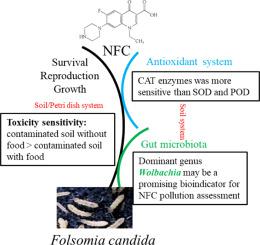Science of the Total Environment ( IF 8.2 ) Pub Date : 2021-05-15 , DOI: 10.1016/j.scitotenv.2021.147793 Simin Li 1 , Jin Li 2 , Zhu Li 3 , Xin Ke 2 , Longhua Wu 3 , Peter Christie 3

|
Soils contaminated with antibiotics may exert effects on soil-dwelling animals. A systematic ecological toxicity assessment of norfloxacin on the soil collembolan Folsomia candida (F. candida) was therefore conducted in soil and Petri dish systems with and without feeding at the population, individual and cellular levels. The indicators survival, reproduction, antioxidant enzyme activities peroxidase (POD), catalase (CAT), and superoxide dismutase (SOD), malondialdehyde (MDA) contents and gut microbiota were studied. The surrounding soil microbiota were also investigated because F. candida can ingest soil microbiota that may have effects on the gut microbiota. In general, the toxicity of norfloxacin to F. candida in contaminated soil without food addition was higher than in contaminated soil with food addition. Norfloxacin had little effect at population and individual levels but antioxidant enzyme activities changed significantly in treatments with longer exposure times or higher norfloxacin concentrations. CAT was more sensitive than SOD or POD. The diversity indices and composition at phylum level of the gut microbiota showed little change. However, the operational taxonomic units in the gut decreased in the presence of norfloxacin. The relative abundance of Wolbachia, the predominant bacterial genus in the gut, decreased significantly with increasing soil norfloxacin concentration. Wolbachia may therefore be a promising bioindicator in the assessment of norfloxacin pollution of soils at environmental concentrations.
中文翻译:

诺氟沙星在土壤中对进食和未进食念珠菌(等渗菌:Collembola)以及肠道和土壤微生物群的毒性作用
被抗生素污染的土壤可能会对居住在土壤中的动物产生影响。因此,在土壤和陪替氏培养皿系统中,在种群,个体和细胞水平上有或没有进食的情况下,进行了诺氟沙星对土壤collembolan念珠菌F. candida(F. candida)的系统生态毒性评估。研究了存活,繁殖,抗氧化酶活性过氧化物酶(POD),过氧化氢酶(CAT)和超氧化物歧化酶(SOD),丙二醛(MDA)含量以及肠道菌群的指标。还对周围的土壤微生物群进行了研究,因为念珠菌可以摄取可能对肠道微生物群有影响的土壤微生物群。通常,诺氟沙星对念珠菌的毒性未添加食物的被污染土壤中的污染比未添加食物的被污染土壤中的污染高。诺氟沙星在人群和个体水平上几乎没有影响,但是在暴露时间更长或诺氟沙星浓度更高的治疗中,抗氧化酶的活性发生了显着变化。CAT比SOD或POD更为敏感。肠道菌群门水平的多样性指数和组成变化不大。但是,在存在诺氟沙星的情况下,肠道中的操作分类单位减少了。随着土壤诺氟沙星浓度的增加,肠道中主要细菌属Wolbachia的相对丰度显着降低。沃尔巴契亚 因此在环境浓度下评估诺氟沙星对土壤的污染方面可能是有前途的生物指示剂。











































 京公网安备 11010802027423号
京公网安备 11010802027423号